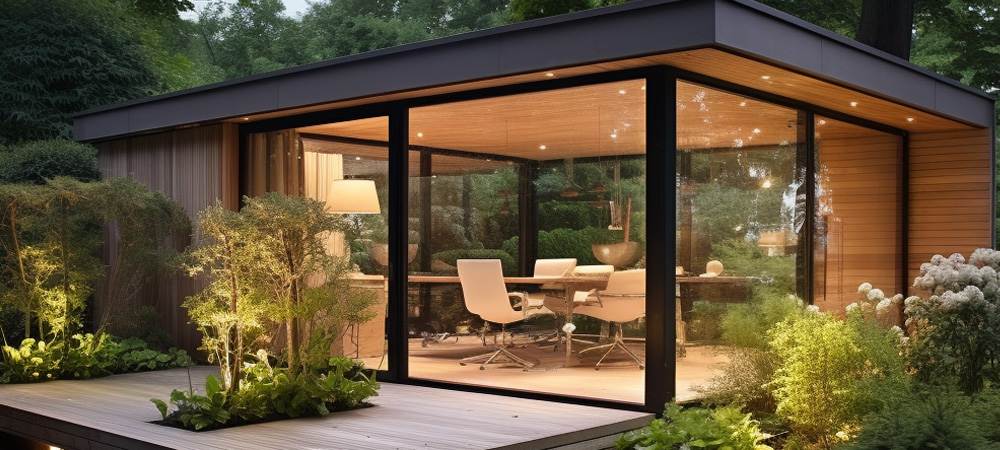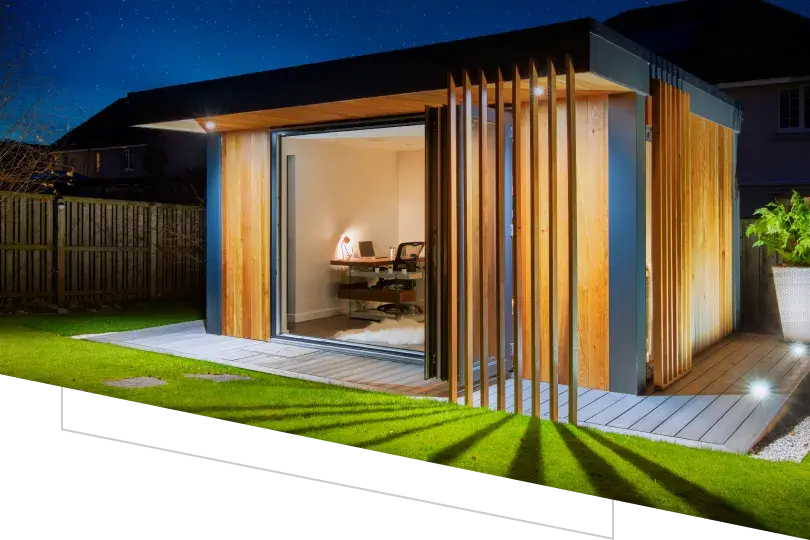Free Facts On Planning Permission On Garden Conservatories
Wiki Article
What Permissions Do You Require For Garden Rooms And Other Structures In Relation To Highways?
When considering the construction of gardens, conservatories, and outhouses, along with extensions or gardens offices, traffic issues are one factor that may affect whether you need planning permission. Here are the main concerns: Sight and Visibility Lines
Planning permission is required when the structure is obstructing the view of drivers coming into and leaving the property or impacts sightlines at intersections or bends on the road. The planning authority must assess whether or not a building could pose a threat to road traffic safety.
Proximity to Highways:
Typically, any structures that are near to the highway such as front gardens or extensions close to the street require planning permission. The distance requirements are very strict. restrictions to ensure the building does not hinder safe traffic operations.
Access and Egress
It is likely that the planning permit will be needed to make changes to existing or new access points. This will ensure that egress and access are safe and won't disturb the flow of traffic.
Parking Arrangements:
Planning permission is required for any new construction that requires parking or alter existing spaces. The planning authority will evaluate whether the development provides adequate parking and does not create congestion for parking on the street.
Traffic Generation
Planning approval is required for development that will generate extra traffic, for example, garden offices, where clients come to. The plan will assess to determine how local traffic and road safety are likely to affect.
Impact on Pedestrian Access
Planning permission will be required in the event that the proposed structure will be intruding on pedestrian paths or walkways. Insuring pedestrian access is not obstructed and is safe for pedestrians is an important aspect to consider.
Impact of Construction on Highways
The impact of construction activities on highways, which includes the moving of heavy vehicles and temporary obstructions, might require planning permission. Planning authorities may set requirements to minimize disruptions to the road network.
Drainage and Water Runoff
The development's impact on drainage and water runoff, and specifically how it impacts the highway is another aspect to be considered. The permission for planning will ensure that the proposed structure does not increase flooding or drainage issues that may cause problems for the road.
Street Furniture and Utilities
A planning permit is required for any construction that will impact street furniture, such as lampposts, signs or underground utilities such as electrical cables and water pipes. The planning authority will coordinate with other agencies relevant to address these issues.
Conformity to Highway Authority Guidelines:
The local highway authority may have specific rules and guidelines for development near highways. To ensure road safety the planning permit is needed to ensure compliance with these regulations.
Noise and Disturbance caused by traffic
If the proposed structure is likely to create noise or disrupt traffic (e.g. gardens offices that receive visitors or deliveries) Planning permission will need to be obtained in order to determine the impact and mitigate them.
Accessibility to public transport
The development must be approved by the council that may impact accessibility to public transport such as trains or bus stops. Planning permission will be required for projects that may affect public transport infrastructure like train stations or bus stops.
The impact of highways is a crucial aspect in determining if an extension, conservatory, garden room, outhouse, garden office or extension is accepted. The need to ensure that the proposed project doesn't negatively impact road safety, traffic flow pedestrian accessibility, as well as the overall infrastructure is essential. Talking with the local planning authority and the highway authority early in the process of planning can aid in addressing these concerns and help ensure that the development is in compliance with all relevant laws. Read the top rated what is a conservatory room for website examples including herts garden rooms, garden outhouses, copyright outhouse, copyright garden rooms, ground screws vs concrete base, insulated garden rooms, garden outhouses, insulated garden rooms, insulated garden rooms, armoured cable for garden room and more.

What Planning Permissions Are You Required To Obtain For Your Garden Rooms Etc In Terms Of Environmental Impact?
The environmental impact of building garden rooms, conservatories or outhouses, as well as extension and garden offices can have a significant influence on the necessity of an application for a permit to plan. Here are the main environmental considerations to take into account wildlife and biodiversity
If the proposed construction will affect local wildlife habitats such as hedgerows trees or ponds, then planning permission is required. An ecological study could be required to determine and mitigate the impacts on biodiversity.
Habitats and species that are protected:
If the location is home to protected species (e.g., bats, newts, etc.)) or is within or close to protected habitats (e.g., Sites of Special Scientific Interest : SSSI), planning permission is crucial. Special measures must be taken to protect them.
Tree Preservation Orders
Planning permission may be required if the structure includes the removal or modification of trees protected by TPOs. Local authorities will assess any impacts and could demand the replacement of trees or mitigation measures.
Risk and Management of Flood Risk and Water Management
Planning permission is needed to build near waters bodies or areas that are prone to flooding. Assessments of flood risk (FRAs) are sometimes required to ensure the structure doesn't create flood risks and that it has sufficient drainage.
Sustainable Construction Practices
In order to ensure sustainable construction materials and techniques are employed, planning permission may be required. Be aware of energy efficiency as well as insulation and carbon footprint.
Surface Runoff and Drainage
It is important to consider the environmental impact of any new construction. Planning permission is required to ensure that drainage systems are properly constructed in order to stop flooding and waterlogging.
Stability of the soil and stability of the land
If the construction is likely to alter the quality of soil or land stability the need for planning permission. Planning permission is required when the construction may alter soil quality or stability of the land.
Air Quality:
Planning permission is required to build developments close to major highways or industrial zones which could impact local air pollution. The air pollution level must be within acceptable limits and mitigation measures should be in place.
Noise Pollution:
Planning permission is necessary if the garden or an extension would likely create significant noise, like an music studio or workshop. The local authorities will assess noise levels to determine the possible effects of these levels on neighbors and the surrounding environment.
Waste Management:
It is crucial to manage waste properly during and after construction. Planning permission guarantees there are recycling plans and waste disposal in order to reduce environmental impact.
Energy Efficiency
The planning permission may include energy efficiency specifications, for example, using solar panels, high-efficiency glazing or green technologies. This reduces the environmental footprint of the building.
Environmental Regulations Compliance:
Environmental regulations like the UK Environmental Protection Act must be followed in all developments. The permission to plan is needed to make sure that all legal obligations have been fulfilled, and that the development is sustainable for the environment.
Summary: Planning permission for conservatories, garden rooms or outhouses as well as garden extensions and offices should be based on a range of environmental impact. To ensure that the project proposed is environmentally responsible, it is vital to seek out local planning authorities at the earliest stage as you can. Have a look at the top rated air source heat pump for garden room for website advice including garden room heater, Tring garden rooms, best electric heater for cabin, copyright outbuildings, garden rooms brookmans park, what is a garden room, outhouse garden rooms, garden rooms near me, outhouse garden, what size garden room without planning permission uk and more.

What Planning Permits Are Needed For Gardens, Rooms, Etc. In Terms Of Appearance And Design?
When planning to build garden rooms, conservatories, outhouses, garden offices, or extensions the appearance and design of the structure play a significant part in determining if permission for planning is needed. The most important factors to consider:
Planning permission may not be required if the structure you want to build falls within the permitted development right of your property. However, certain criteria must be met with regard to appearance and design.
Size and Scale:
The size and scale must be proportional to the surrounding property and other buildings. The size of the new structure should be in proportion to the property's size and surroundings buildings.
Height and Massing
The size and mass of the new building should be consistent with the size of the existing structure as well as buildings around it. Planning permission is usually required for buildings that are over height limits or out of proportion to the surrounding buildings.
Materials and Finish:
The choice of materials and finishings should match existing buildings and structures around the area. Planning permission could be required if the materials are not compatible with the local character and design.
Design Harmony
The design and style of the new structure should reflect the style and architecture of the current structure. If the proposed design does not match the local character and appearance, planning permission will be required.
Roof Design
The roof's design must be in harmony with the architectural style of the existing building and the surrounding structures. Planning permission may be required if a proposed roof design is not in keeping with the local character and style.
Fenestration:
The design and location of windows and doors should be in harmony with the surrounding property. Planning permission could be required if the proposed fenestration is not in keeping with the local culture and style.
Treatment for Facades
The treatment of the facade must blend in with the surrounding properties and existing buildings. It may be necessary to obtain planning permission for a proposed facade treatment which is not in harmony with the style and character of the area.
Landscaping:
The design of the landscape around a new building must be harmonious with the surrounding structures and existing property. If the landscaping that is proposed is not in keeping with the area, then planning permission might be required.
Visual Impact
Visual impact of the structure on the area surrounding it should be minimized. The proposed structure might require planning permission if it has an adverse aesthetic impact on its surroundings.
Heritage and Conservation Areas
If a property that is located in an area designated as a heritage site or preserving its natural beauty, the design and aesthetic standards could be more strict. For new constructions that do not meet the above criteria an application for planning permission may be required.
Architectural and Planning Guidelines
Local planning authorities typically have strict guidelines on the design and appearance of buildings. Planning permission might be required if the proposed structure is not in accordance to these standards.
In short, planning permission for conservatories, garden rooms, outhouses, gardens offices, or extensions often hinges on the design and appearance of the structure being proposed. It is essential to consult prior to constructing with local authorities to determine whether or not planning permission is necessary and to ensure that the style is in line with local character guidelines. Take a look at the top rated [no maintenance cladding] for more examples including best electric heater for cabin, Tring garden rooms, outhouse garden rooms, garden buildings , copyright outhouse, garden room, copyright garden room, what size garden room without planning permission, copyright outbuildings, insulated garden buildings and more.
